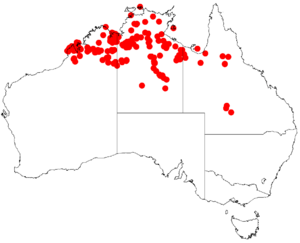Acacia neurocarpa facts for kids
Quick facts for kids Acacia neurocarpa |
|
|---|---|
| Scientific classification | |
| Genus: |
Acacia
|
| Species: |
neurocarpa
|
 |
|
| Occurrence data from AVH | |
Acacia neurocarpa is a type of shrub or tree that belongs to the Acacia family, also known as wattles. It's special because it only grows naturally in northern Australia, meaning it's endemic there.
What it Looks Like
This tree or shrub usually stands straight and can grow from 2 to 8 meters (about 6 to 26 feet) tall. Its branches are strong and have clear angles. When new shoots appear, they look silvery.
Like most Acacia plants, it doesn't have regular leaves. Instead, it has what are called phyllodes. These are flattened leaf stems that act like leaves. The phyllodes of Acacia neurocarpa are grey-green and stay on the plant all year. They are shaped like a narrow oval, usually 12 to 25 centimeters long (about 5 to 10 inches) and 3 to 5.5 centimeters wide (about 1 to 2 inches). Each phyllode has three clear veins.
This plant blooms with yellow flowers between June and October. The flowers grow in long, cylinder-shaped clusters called flower-spikes, which are about 4 to 7 centimeters long (about 1.5 to 2.5 inches). These spikes are packed with bright golden flowers.
After the flowers, seed pods form. These pods are thin but tough, and they coil up tightly and unevenly. They are about 3 to 4 millimeters wide (less than half an inch). When they are young, they are green, but they turn brown as they get older. Inside the pods are shiny brown to black seeds. Each seed is shaped like an oblong and is about 3 to 5 millimeters long. They also have a yellow part called an aril, which often helps with seed dispersal.
How it Was Named
The first time this plant was officially described was in 1837 by a botanist named William Jackson Hooker. He included it in his work called Icones Plantarum.
Later, in 2003, another botanist named Leslie Pedley reclassified it and gave it the name Racosperma neurocarpum. However, in 2006, it was moved back to the Acacia family. It also has other names that were used in the past, like Acacia holosericea var. neurocarpa.
Where it Grows
Acacia neurocarpa is found naturally in the Kimberley region of Western Australia. You can also find it spread out across the top end of the Northern Territory. It grows as far east as a place called Springvale, which is near the border with Queensland.
This plant often grows along ephemeral watercourses, which are streams or rivers that only flow after it rains. It prefers sandy or loamy soils. You'll usually find it as part of a riparian forest (forests along riverbanks) or in open woodlands, often alongside Melaleuca trees.
Images for kids


